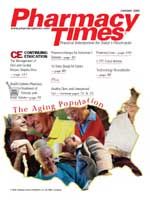Publication
Article
Pharmacy Times
Nutrients to Reduce Hypertension
Author(s):
Pharmacists can safely recommendseveral nutrients that canbe helpful in the preventionand treatment of hypertension. Thisarticle will discuss magnesium, coenzymeQ10 (CoQ10), fish oils, vitaminC, and garlic. Although potassium isanother important blood pressure-regulating nutrient, physicians usuallymonitor potassium levels in hypertensivepatients, however, so I havenot included potassium in this article.
Magnesium
Magnesium is one of the mostcommonly deficient nutrients inAmerican diets, and it is one of themost critical nutrients required forregulating and maintaining normalblood pressure. A meta-analysis of34 clinical trials revealed a strong,consistent inverse relationshipbetween magnesium levels andblood pressure.1 In the HonoluluHeart Study, which evaluated 61nutritional variables, magnesiumintake had the strongest associationwith blood pressure.2
Numerous studies report that magnesiumsupplementation effectivelylowers blood pressure in patientswith hypertension. For example,researchers found that all patientswith elevated blood pressure taking625 mg of magnesium daily for 4weeks experienced significant reductionsin blood pressure.3 A double-blind,placebo-controlled trialshowed that magnesium supplementationproduced significant reductionsin both systolic and diastolicblood pressures.4 Results from a 6-week, double-blind, placebo-controlledtrial showed that magnesium(600 mg/day) lowered intracellularsodium levels in addition to producingsignificant decreases in systolicand diastolic blood pressures.5
Because a large single dose of magnesiumcan cause diarrhea, I routinelysuggest that people take 200 to300 mg of magnesium 2 or 3 timesdaily. Also, patients who take drugsthat can cause magnesium depletion—such as estrogen-containingmedications (oral contraceptives andhormone replacement therapy),loop and thiazide diuretics, anddigoxin—may need additional magnesiumsupplementation.6
Coenzyme Q10
CoQ10 is another very effectivenutritional antihypertensive agent.Peter Langsjoen, a cardiologist, conducteda remarkable study usingCoQ10 in patients with hypertension.He initiated high-dose coenzymeQ10 therapy in 109 hypertensivepatients. In 80% of thesepatients, the diagnosis of essentialhypertension had been establishedfor a year or more prior to startingCoQ10, with an average time of 9.2years since diagnosis. Dosages wereadjusted to meet a target blood levelof 2 mcg/mL (the average oral doseused was 225 mg/day). Within 1 to6 months (average 4.4 months),51% of these patients were able tocompletely discontinue from 1 to 3antihypertensive medications.7
Additional CoQ10 studies conductedin Japan have reported similarantihypertensive benefits.8,9Dosages generally range from 100 to200 mg/day. Because CoQ10 is a fat-solublenutrient, it should be takenwith a meal containing fat, whichwill enhance its absorption.
Fish Oils
The long-chain omega-3 fattyacids EPA and DHA, known as fishoils, also lower blood pressure. In ameta-analysis of 31 placebo-controlledclinical trials, both eicosapentaenoicacid (EPA) and docosahexaenoicacid (DHA) providedblood pressure-lowering benefits inhypertensive individuals.10 In thesestudies, patients ingested from 3 to15 g of fish oils daily. One study provideda mechanism of action for theblood pressure-lowering effects ofEPA and DHA. Apparently theselong-chain omega-3 fatty acidsimprove the elasticity of the arteries,which results in a reduction of bloodpressure and vascular resistance.
In a 7-week, double-blind, placebo-controlled trial, 38 volunteersreceived 3 g of either EPA or DHA ora placebo. The EPA group registereda 36% improvement in arterialfunction, and the DHA group had a27% improvement, but the placebogroup experienced no improvement.11
It is important to recommendextra antioxidants (especially vitaminE) for people taking omega-3supplements. A good level of naturalvitamin E is 400 internationalunits, and now studies indicate thattaking mixed tocopherols is betterthan just taking vitamin E as dalphatocopherol.
Vitamin C
Several studies report an inverserelationship between plasma levelsof vitamin C (ascorbic acid) andblood pressure.12,13 In one study,volunteers were fed a vitaminC-deficient diet for 30 days, followedfor 30 days by a diet containingadequate vitamin C. Individualswho experienced the greatest reduction in plasma vitamin C levels hadthe largest increases in blood pressure1 month later. People in the lowest25th percentile of plasma vitamin Clevels had blood pressure readings7 mm Hg higher than people in theupper 25th percentile of plasma vitaminC levels.14
A mechanism of action for the bloodpressure-lowering effects of vitamin Cis now known. It has been shown thatvitamin C improves endothelium-dependentvasodilation by restoring orimproving the production of endothelialnitric oxide in patients with essentialhypertension.15 Several studiesreport that a significant number ofAmericans (especially smokers, AfricanAmericans, Hispanics, and the elderly)have low dietary levels and low bloodlevels of ascorbic acid, which may beone of the causes of hypertension.
Garlic
Garlic is a natural agent that hasmild antihypertensive effects. In ameta-analysis of 10 randomized clinicaltrials lasting 4 weeks or longer,doses ranging from 600 to 900 mg ofgarlic extract per day provided a loweringof systolic and/or diastolic bloodpressure.16
A Word of Caution
High-dose magnesium and/or coenzymeQ10 can be so effective in somehypertensive individuals that dosagelevels of antihypertensive drugs mayneed to be reduced. For this reason, Isuggest that patients who are takingblood pressure drugs contact theirphysicians before beginning thesetherapies.
Dr. Pelton is director ofeducation at IntegrativeHealth Resources Inc.continued from page 18continued from page 34
For a list of references, send a stamped, self-addressedenvelope to: References Department,Attn. A. Stahl, Pharmacy Times,241 Forsgate Drive, Jamesburg, NJ 08831;or send an e-mail request to: [email protected].







